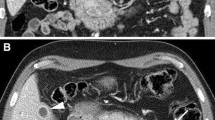Abstract
Purpose
To compare the cross-sectional imaging findings of immunoglobulin G4-related sclerosing cholangiopathy (IgG4-SC) and cholangiocarcinoma (CCA).
Methods
Retrospective search of radiology and pathology databases identified 24 patients with IgG4-SC and over 500 patients with CCA from January 2009 to December 2016. Patients with no pre-treatment imaging studies available on PACS, non-contrasted imaging only, presence of mass lesions, metastatic disease or biliary stents were excluded. 17 patients with IgG4-SC and a selected group of 20 (age and gender matched) patients with CCA were obtained. Images were blinded and independently reviewed by two radiologists. Differences in proportions and means between groups were analyzed using Fishers and Mann–Whitney tests, respectively.
Results
Both readers identified a statistically significant difference in the presence of abrupt common bile duct narrowing between IgG4-SC and CCA (6.7% vs. 68.4%, p < 0.001; 33.3% vs. 75%, p = 0.019). No difference was seen in biliary wall thickening, wall enhancement, extrahepatic exclusive location of disease, or pancreatic duct dilation. Inter-observer variability was κ = 0.52. Total bilirubin and CA 19-9 were unable to differentiate between IgG4-SC and CCA. Serum IgG4 was positive in two of six IgG4-SC patients who were tested.
Conclusion
IgG4-SC and CCA share many clinical and imaging findings on CT and MRI. Abrupt bile duct cut sign strongly favors CCA. In the absence of this finding, IgG4-SC should be considered in the differential diagnosis in all cases of suspected extrahepatic CCA.


Similar content being viewed by others
References
Katabathina V, Khalil S, Shin S, Lath N, Menias CO, Prasad SR (2016) Immunoglobulin G4-Related Disease: Recent Advances in Pathogenesis and Imaging Findings. Radiol Clin N Am 54:535–551
Vlachou P, Khalili K, Jang HJ, Fischer S, Hirschfield GM, Kim TK (2011) IgG4-related Sclerosing Disease: Autoimmune Pancreatitis and Extrapancreatic Manifestations. Radiographics 31:1379–1402
Al Zahrani H, Kyoung KT, Khalili K, Vlachou P, Yu H, Jang HJ (2014) IgG4-Related Disease in the Abdomen: A Great Mimicker. Seminars in Ultrasound CT MRI 35:240–254
Itoh S, Nagasaka T, Suzuki K, Ota T, Naganawa S (2009) Lymphoplasmacytic sclerosing cholangitis: assessment of clinical, CT, and pathological findings. Clinical Radiology 64:1104–1114
Hamano H, Kawa S, Uehara T, et al (2005) Immunoglobulin G4-related lymphoplasmacytic sclerosing cholangitis that mimics infiltrating hilar cholangiocarcinoma: part of a spectrum of autoimmune pancreatitis? Gastrointestinal Endoscopy 62(1): 152–157
Kim JH, Byun JH, Kim SY et al (2013), Sclerosing cholangitis with autoimmune pancreatitis versus primary sclerosing cholangitis: comparison on endoscopic retrograde cholangiography, MR cholangiography, CT, and MRI. Acta Radiologica 54:601–607
Olsson R, Glaumann H, Almer S et al (2009) High prevalence of small duct primary sclerosing cholangitis among patients with overlapping autoimmune hepatitis and primary sclerosing cholangitis. European Journal of Internal Medicine 20:190–196
Oh HC, Kim MH, Lee KT et al (2010) Clinical clues to suspicion of IgG4-associated sclerosing cholangitis disguised as primary sclerosing cholangitis or hilar cholangiocarcinoma. Journal of Gastroenterology and Hepatology 25:1831–1837
Deshpande V, Sainani NI, Chung RT et al (2009) IgG4-associated cholangitis: a comparative histological and immunophenotypic study with primary sclerosing cholangitis on liver biopsy material. Modern Pathology 22:1287–1295
Sivakumaran Y, Le Page PA, Becerril-Martinez G et al (2014) IgG4-related sclerosing cholangitis: the cholangiocarcinoma mimic. ANZ J Surg 84:486–487
Ghazale A, Chari S, Smyrk T, Takahashi N, Levy M (2008) Immunoglobulin G4-Associated Cholangitis: Clinical Profile and Response to Therapy. Gastroenterology 134:706–715
Khosroshahi A, Stone JH (2011) A clinical overview of IgG4-related systemic disease. Curr Opin Rheumatol 23(1):57–66
Culver EL, Barnes E (2017) IgG4-related sclerosing cholangitis. Clinical Liver Disease 10(1): 9–16
Soares KC, Kamel I, Cosgrove DP, Herman JM, Pawlik TM (2014) Hilar cholangiocarcinoma: diagnosis, treatment options, and management. Hepatobiliary Surg Nutr. 3(1): 18–34
Deshpande V, Zen Y, Chan JK, et al (2012) Consensus statement on the pathology of IgG4-related disease. Mod Pathol 25:1181–1192.
Yata M, Suzuki K, Furuhashi N, Kawakami K, Kawai Y, Naganawa S (2016) Comparison of the multidetector-row computed tomography findings of IgG4-related sclerosing cholangitis and extrahepatic cholangiocarcinoma. Clinical Radiology 71:203–210
Tabata T, Kamisawa T, Hara S, et al (2013) Differentiating immunoglobulin g4-related sclerosing cholangitis from hilar cholangiocarcinoma. Gut Liver 7(2):234–238
Malaguarnera G, Paladina I, Giordano M, Malaguarnera M, Bertino G, Berretta M (2013) Serum markers of intrahepatic cholangiocarcinoma. Dis Markers 34(4):219.
Ohara H, Okazaki K, Tsubouchi H et al (2012) Clinical diagnostic criteria of IgG4-related sclerosing cholangitis 2012. J Hepatobiliary Pancreat Sci. 19(5):536–42
Funding
None.
Author information
Authors and Affiliations
Corresponding author
Ethics declarations
Conflict of interest
Dr. Temel Tirkes was supported by National Cancer Institute and National Institute of Diabetes and Digestive and Kidney Diseases of the National Institutes of Health under Award Numbers 1R01DK116963-01A1 and U01DK108323 (Consortium for the Study of Chronic Pancreatitis, Diabetes, and Pancreatic Cancer). The content is solely the responsibility of the authors and does not necessarily represent the official views of the National Institutes of Health.
Additional information
Publisher's Note
Springer Nature remains neutral with regard to jurisdictional claims in published maps and institutional affiliations.
Rights and permissions
About this article
Cite this article
Swensson, J., Tirkes, T., Tann, M. et al. Differentiating IgG4-related sclerosing cholangiopathy from cholangiocarcinoma using CT and MRI: experience from a tertiary referring center. Abdom Radiol 44, 2111–2115 (2019). https://doi.org/10.1007/s00261-019-01944-1
Published:
Issue Date:
DOI: https://doi.org/10.1007/s00261-019-01944-1




